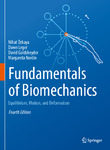| dc.description.abstract | Biomechanics is an exciting and fascinating specialty with the
goal of better understanding the musculoskeletal system to
enable the development of methods to prevent problems or to
improve treatment of patients.
Biomechanics has increasingly become an interdisciplinary
field where engineers, physicists, computer scientists,
biologists, and material scientists work together to support
physicians, sports scientists, ergonomists, and physiotherapists
and many other professionals.
This book Fundamentals of Biomechanics summarizes the basics
of mechanics, both static and dynamics including kinematics
and kinetics. The book introduces vectors and moments, applying
them with many simple examples, which are essential to
determine quantitatively or at least estimate loads acting during
different situations or exercises on bones and joints. Joints and
bones are mostly stabilized by their associated ligaments and
muscles and therefore such calculations also require knowledge
of the complex anatomy. Creativity is also needed to simplify
these often complicated scenarios to reduce the parameters for
the free body diagrams that can be used to develop the
equations that can be solved. This book presents the concepts
and explains in detail examples for the elbow, the shoulder, the
spinal column, the neck, the lumbar spine, the hip and the knee,
as well as the ankle joint. The reader however should also be
aware that results from such calculations should be validated
with available in vivo studies because muscle forces are often
not known and the simplifications may be too strong. | en_US |

